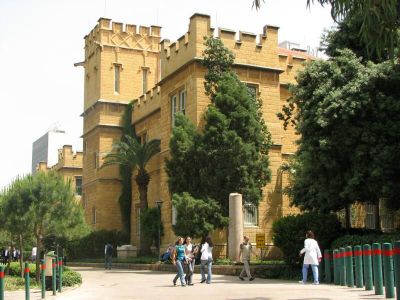Post Hall (A.U.B Archaeological Museum), Beirut
The Archaeology Museum of the American University of Beirut is a historic institution located in Beirut. It stands as the third oldest museum in the Near East, following those in Cairo and Constantinople. Established in 1868, the museum's foundation was initiated when Luigi Palma di Cesnola gifted a collection of Cypriot pottery to the then-newly-formed American University of Beirut. The first curator of the museum was Georges Post, after whom Post Hall, the museum's dedicated building funded by Morris Jesup, was named. Post Hall opened its doors in 1902.
The early years of the museum were marked by rapid growth in its collections, acquiring a wide range of artifacts from across the Middle East between 1902 and 1938. However, this period was also rife with archaeological plundering in Lebanon, which contributed artifacts to the museum from clandestine excavations. The museum closed during World War II and reopened in 1948, subsequently undergoing significant expansions and renovations. In the 1950s, under curator Dimitri Baramki, the museum doubled its floor space and reopened to the public in 1964 after extensive refurbishment.
Under the leadership of its current curator, Nadine Panayot, since September 2020, the museum is embracing a digital era and has embarked on major restoration efforts, particularly following the extensive damage caused by the August 4th blast in Beirut.
The museum displays pottery collections chronologically and thematically, illustrating its evolution. Highlights include the Cesnola Collection spanning Cypriot pottery from the Bronze Age to the Roman era, and a prehistoric collection featuring artifacts from the Paleolithic and Neolithic periods. Particularly noteworthy is the Ksar Akil collection donated by the University of Boston, showcasing a 23-meter stratigraphic sequence with flint tools and human remains dating back 50,000 to 18,000 years.
The early years of the museum were marked by rapid growth in its collections, acquiring a wide range of artifacts from across the Middle East between 1902 and 1938. However, this period was also rife with archaeological plundering in Lebanon, which contributed artifacts to the museum from clandestine excavations. The museum closed during World War II and reopened in 1948, subsequently undergoing significant expansions and renovations. In the 1950s, under curator Dimitri Baramki, the museum doubled its floor space and reopened to the public in 1964 after extensive refurbishment.
Under the leadership of its current curator, Nadine Panayot, since September 2020, the museum is embracing a digital era and has embarked on major restoration efforts, particularly following the extensive damage caused by the August 4th blast in Beirut.
The museum displays pottery collections chronologically and thematically, illustrating its evolution. Highlights include the Cesnola Collection spanning Cypriot pottery from the Bronze Age to the Roman era, and a prehistoric collection featuring artifacts from the Paleolithic and Neolithic periods. Particularly noteworthy is the Ksar Akil collection donated by the University of Boston, showcasing a 23-meter stratigraphic sequence with flint tools and human remains dating back 50,000 to 18,000 years.
Want to visit this sight? Check out these Self-Guided Walking Tours in Beirut. Alternatively, you can download the mobile app "GPSmyCity: Walks in 1K+ Cities" from Apple App Store or Google Play Store. The app turns your mobile device to a personal tour guide and it works offline, so no data plan is needed when traveling abroad.
Post Hall (A.U.B Archaeological Museum) on Map
Sight Name: Post Hall (A.U.B Archaeological Museum)
Sight Location: Beirut, Lebanon (See walking tours in Beirut)
Sight Type: Museum/Gallery
Sight Location: Beirut, Lebanon (See walking tours in Beirut)
Sight Type: Museum/Gallery
Walking Tours in Beirut, Lebanon
Create Your Own Walk in Beirut
Creating your own self-guided walk in Beirut is easy and fun. Choose the city attractions that you want to see and a walk route map will be created just for you. You can even set your hotel as the start point of the walk.
Seaside Walking Tour
If you wish to unwind or, perhaps, seek some quality time with your family and friends in a completely safe environment, while in Beirut, the local seaside area offers ample opportunities for both. Lined with palm trees, the city's waterfront guarantees a truly joyful experience and is as much fun for watching the Mediterranean, beautiful people and breathing the air as it is for exploring... view more
Tour Duration: 2 Hour(s)
Travel Distance: 3.2 Km or 2 Miles
Tour Duration: 2 Hour(s)
Travel Distance: 3.2 Km or 2 Miles
Beirut Introduction Walking Tour
How many times can a city die? Beirut, in 5,000 years, has died and come back many times. Archeological digs downtown have revealed Phoenician, Greek, Roman, Byzantine, Arab, Crusader and Ottoman remains and signs of influence.
In 140 BC the city was destroyed by Diodotus Tryphon, a king of the Seleucid Empire. His Hellenistic city lies over the Phoenician one. Pompey the Great arrived in 64 BC... view more
Tour Duration: 2 Hour(s)
Travel Distance: 3.3 Km or 2.1 Miles
In 140 BC the city was destroyed by Diodotus Tryphon, a king of the Seleucid Empire. His Hellenistic city lies over the Phoenician one. Pompey the Great arrived in 64 BC... view more
Tour Duration: 2 Hour(s)
Travel Distance: 3.3 Km or 2.1 Miles





